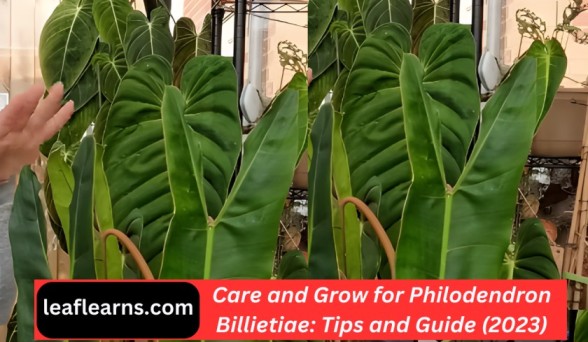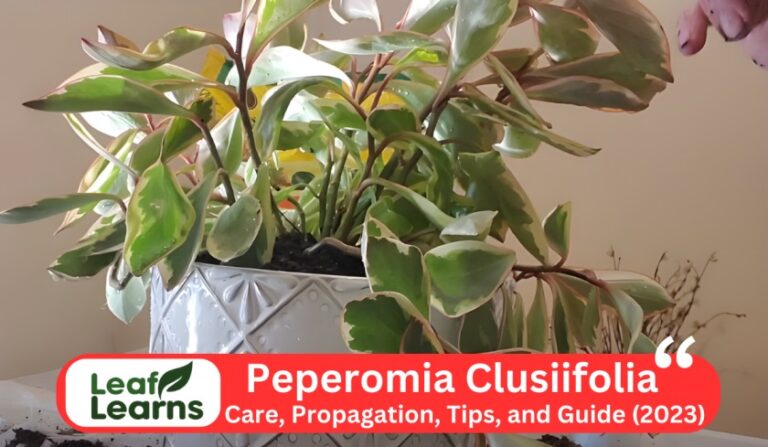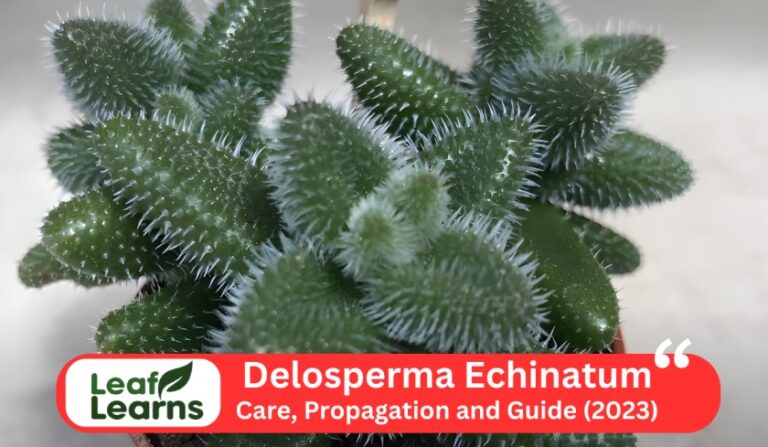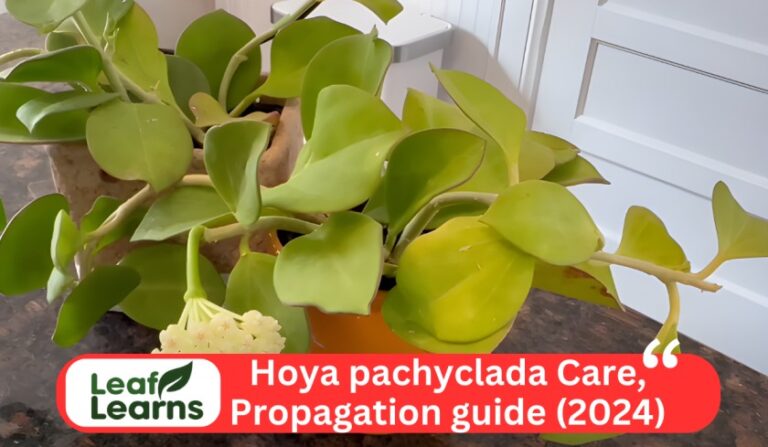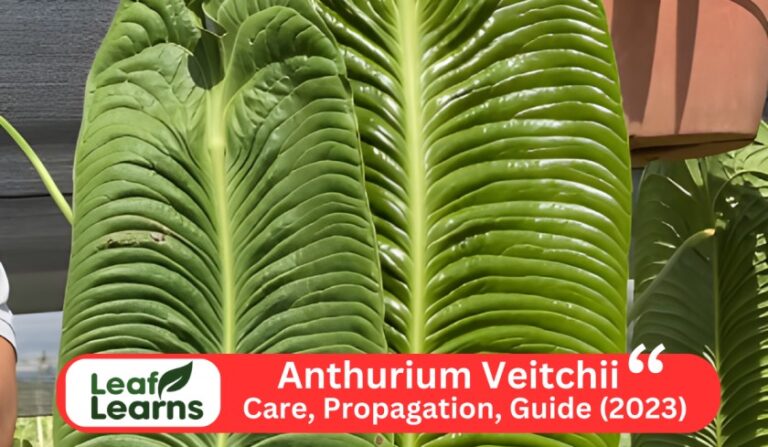Peperomia Turboensis Care and Propagation Guide(2023)
| Common Name | Peperomia Turboensis (Raindrop Peperomia) |
| Botanical Name | Peperomia Turboensis |
| Family | Piperaceae |
| Ragion | South America |
| Light | Bright, indirect light; can tolerate some shade |
| Temprature | 65-75°F (18-24°C) |
| Humidity | Moderate to high |
| Watering | Allow the top inch of soil to dry out before watering; water sparingly in winter |
| Soil | Well-draining potting mix with good aeration |
| Fertilization | Fertilize every 2-4 weeks during the growing season with a balanced, diluted liquid fertilizer |
| Pruning | Prune leggy or overgrown stems |
| Propagation | Propagate through leaf or stem cuttings |
| Pests | Susceptible to mealybugs and spider mites |
| Toxicity | Non-toxic to pets and humans |
Because of its unique and captivating look, Peperomia Turboensis, a beautiful member of the Peperomia family, is a favorite among enthusiasts of indoor plants. This lovely plant is indigenous to Colombia in South America, where it flourishes in humid jungles.
This plant has glossy, deep green leaves with noticeable silver stripes that contrast sharply and enhance its visual appeal.
This plant type is a versatile option for any area because of its compact growth habit and relatively slow development rate, which make it well-suited for indoor situations and can flourish in low to medium-light circumstances.
Additionally, its minimal maintenance needs make it a great option for both inexperienced and experienced plant aficionados. It only requires routine irrigation, drained soil, and sporadic shaping trimming to thrive.
Peperomia-Turboensis is certain to become a beloved addition to any indoor plant collection because to its attractive beauty and accessibility to maintenance.
Contents
- 1 Peperomia Care and Varieties: A Guide for Indoor Plant Enthusiasts
- 2 Optimal Soil and Maintenance Tips for Healthy Peperomia Plants
- 3 The History and Varieties of Peperomia Turboensis
- 4 Distinctive Characteristics:
- 5 Care and Cultivation
- 6 Aesthetic Elements
- 7 Safety and Versatility
- 8 Specialized Uses
- 9 YouTube:
- 10 Meet the Peperomia-Turboensis
- 11 Distinctive Appearance:
- 12 Compact Size:
- 13 Low Maintenance:
- 14 How to Propagate Peperomia Turboensis
- 15 How to Propagate Peperomia by Stem Cuttings in Soil
- 16 How to Propagate Peperomia by Leaf Cuttings
- 17 Caring for Your Peperomia Turboensis
- 18 How to propagate peperomia from a stem cutting
- 19 FAQs
- 19.1 Peperomia turboensis indoor care?
- 19.2 How to propagate Peperomia turboensis?
- 19.3 Peperomia turboensis care?
- 19.4 What are the unique characteristics of this plant that make it a favorite among indoor plant enthusiasts?
- 19.5 What are the key care guidelines for maintaining a healthy Peperomia Turboensis plant?
- 19.6 How can Peperomia Turboensis be propagated, and what are the recommended methods for successful propagation?
- 20 Conclusion:
Peperomia Care and Varieties: A Guide for Indoor Plant Enthusiasts
Peperomia has grown in popularity among fans of indoor plants because of its attractive round leaves and several variants, including Peperomia-Turboensis Aurea and Peperomia Turboensis Bleu. These plants require careful attention, including frequent Peperomia taille (pruning) to keep their size and form.
A well-draining mixture is necessary for Peperomia terre (soil) to avoid waterlogged roots. Intriguing colors like Peperomia Turboensis Gold or Peperomia Turboensis Jaune are frequently seen on peperomia plants, which are renowned for their distinctive tige (stems).
With the proper peperomia terreau (potting soil) and peperomia engrais (fertilizer), you can ensure their success. Their small size makes them perfect for interior settings.
Optimal Soil and Maintenance Tips for Healthy Peperomia Plants
Collectors of peperomia may discover a variety of species, from the traditional Peperomia Obtusifolia to more unusual varieties like Peperomia Quadrangularis. Each species needs particular Peperomia entretien (care), which includes paying attention to temperature, light, and watering.
Understanding each variety’s particular requirements is crucial whether you have a Peperomia-Turboensis Floraison (blooming) or a Peperomia Rotundifolia Terreau (potted in soil).
These adaptable plants may either function as a prominent peperomia exterior (outside) plant or a wonderful enhance to your peperomia mix. With enough knowledge and attention, you can appreciate Peperomia’s beauty in a variety of shapes, sizes, and colors.
The History and Varieties of Peperomia Turboensis
The Peperomia genus has a rich history dating back centuries, with its name derived from the Greek words “peperi” (pepper) and “homoios” (resembling), owing to the peppery flavor of some of its species.
While this plant is a relatively recent addition to the world of houseplants, it has quickly gained popularity due to its striking appearance and ease of care.

Distinctive Characteristics:
This Peperomia plant is an important component of the Peperomia family and is well known for its spectacular look and low maintenance requirements.
Feuille Ronde (Round Leaves):
The charm of this type of plant lies in its captivating, round leaves, which introduce an element of elegance to any indoor setting.
Care and Cultivation
Entretien (Care):
This plant needs well-draining soil, indirect sunlight, and regular watering to be successfully grown. This tropical plant is a great choice for indoor gardening since it thrives in warm, muggy environments.
Variétés (Varieties):
While Peperomia-Turboensis stands out as a distinct variation, the larger Peperomia genus has a wide range of unique species, each of which offers a unique combination of traits and aesthetic appeal.
Indica (Indica Strain):
The indica strain, a subset of the Peperomia family, has growth patterns and characteristics that resemble those of the indica family, providing mystery to its cultivation.
Aesthetic Elements
Orange (Orange Color):
Some Turboensis specimens exhibit delightful orange hues, infusing vibrancy and playfulness into indoor gardens.
Floraison (Flowering):
During its growing period, Peperomia plant may introduce inconspicuous yet charming flowers, enhancing its overall aesthetic and character.
Safety and Versatility
Toxicity and Safety:
This plant is generally regarded as safe for families with cats and dogs, although it does call for proper pet keeping, including close observation and quick veterinarian consultation in the event of ingestion.
Extérieur (Outdoor):
While predominantly an indoor favorite, the plants can also thrive in outdoor settings, provided it is shielded from direct sunlight.
Specialized Uses
Terrarium (Terrariums):
Plant is a well-liked choice for making captivating terrariums because of its small size and aesthetically pleasing leaves, which add a touch of green enchantment to little ecosystems contained in glass.
YouTube:
For valuable insights and care tips, look no further than online platforms like YouTube, where you can find a wealth of information on Peperomia-Turboensis and its cultivation.
There are several options accessible in the world of indoor gardening when it comes to houseplants. Every taste and level of gardening expertise may be satisfied with a plant, from the classic peace lily to the modern fiddle leaf fig. The plant is a well-kept secret that deserves greater attention from those looking to give their indoor sanctuary a touch of individuality and charm. With its stunning appearance, low maintenance needs, and intriguing history, this attractive plant is sure to become a favourite among plant aficionados.

Meet the Peperomia-Turboensis
As a perennial herb, vine, and succulent, this plant, sometimes referred to as the “Raindrop” or “Raindrop Radiator Plant,” is a part of the large Peperomia family, which has over 1,500 species. Due to its ubiquitous appearance, this particular Peperomia species, which is native to the tropical rainforests of Central and South America, has captured the interest of indoor gardeners all over the world.
Distinctive Appearance:
The Turboensis most distinctive feature is its leaves. They are thick, meaty, and glistening, with a characteristic teardrop shape that tapers to a point that resembles raindrops frozen in time. Even though the leaves are often a rich shade of green, certain varieties may contain streaks of silver or white, which raises the visual appeal a notch.
.
Compact Size:
One of the Peperomia-Turboensis’ main advantages as a houseplant is its small size. Due to the fact that it typically grows to a height of 6 to 12 inches, it is the ideal choice for small spaces or as a decorative accent on shelves, tables, or windowsills.
Low Maintenance:
If you’re looking for a low-maintenance plant or are just a beginner gardener, the Peperomia-Turboensis is an excellent option. It thrives in a variety of indoor conditions and needs minimal upkeep. With the right care, it might bloom for many years, lengthening the life of your indoor garden.
How to Propagate Peperomia Turboensis
How to Propagate Peperomia by Stem Cuttings in Water
One of the simplest and most effective ways to spread peperomia is by stem cuttings in water. Transparent containers make it simple to keep an eye on the stem’s roots’ development and make sure everything is progressing as planned.
Take Stem Cuttings
Using a pair of tidy pruning shears or scissors, remove a stem from your peperomia plant, being sure that the stem contains leaves.
Place Cuttings in Water
The cutting should be placed in a small water-filled vase or container. The leaf must remain on the surface. A bright, indirect light source should be near the container, and the water should be changed once per week.
Transfer to Soil Once New Leaves Have Sprouted
Although roots will begin to grow within the first two weeks, it is best to wait until the cutting begins to sprout new leaves before planting it in soil.
The rooted stem cutting has to be put in a small pot with potting soil that drains effectively. After planting, give the young plant lots of water. To help the roots adjust, keep the soil consistently moist throughout the first week.
How to Propagate Peperomia by Stem Cuttings in Soil
This method could be a bit more difficult to master because the cuttings require more attention to root successfully. Some people like this straightforward method since the cuttings don’t need to be moved from water to soil after they have established.
Take Stem Cuttings
Use a pair of tidy pruning shears or scissors to remove a stem off your peperomia plant, cutting towards the base of the stem.
Dip Cuttings in Rooting Hormone
Take the end of each cutting and gently dip it in a rooting hormone before planting it in the soil.
Plant Cuttings in Soil
The cuttings should be planted in a small container with a soil combination that drains well and get plenty of water.
Create a Greenhouse Environment
To help the cutting take root in the soil, high humidity is required, which is often only possible in a greenhouse. To replicate this environment, cover the pot in a zip-close clear plastic bag or use seed starting trays with clear plastic coverings.
Whatever you choose to do, make sure to take off the cover once or twice weekly for 10 to 15 minutes so you can let the plants breathe.
Remove Cover Once New Leaves Have Sprouted
The cuttings should remain in the greenhouse environment even when there are signs of new growth. After that, they might be removed and reacclimatized to the normal humidity levels in a house. The soil should be kept evenly moist for the first several weeks, up until it is clear that the new plants have established.
How to Propagate Peperomia by Leaf Cuttings
Last but not least, peperomia may be propagated through leaf cuttings. Here, it’s crucial to leave a small portion of stem on each cutting since here is where the new roots and leaves will grow. For leaf propagation, non-variegated peperomia varieties make good choices.
Take Leaf Cuttings
Take leaf cuttings from a healthy peperomia plant using a pair of clean pruning shears or scissors. Make slits at the base of each leaf, being sure to leave a little stem attached to each cut.
Dip Cuttings in Rooting Hormone
Take the cut end of each leaf cutting and gently dip it in a rooting hormone before planting it in soil.
Plant in Soil
Plant the leaf cuttings in a soil mixture that drains well, being sure to bury the leaf’s stem in the soil. To do this, you might need to partially bury the leaf, which is OK. It will be content as long as some of the leaf is exposed above the ground.
Create a Greenhouse Environment
Similar to how stem cuttings are propagated in soil, leaf cuttings likewise need a humid environment to flourish in for the first several weeks. Using seed starting trays or a transparent plastic zip-close bag are also excellent choices. While it’s inside the greenhouse, keep the soil uniformly moist and take the cover or bag off once every few days to let the plant breathe.
Remove Cover Once New Leaves Have Sprouted
A leaf cutting will probably take a little longer to sprout new growth, but once it does, it may be taken out of its greenhouse setting and acclimated back to the humidity of a typical home. At this time, you may also start reducing the amount of water you use by letting the soil somewhat dry between applications.
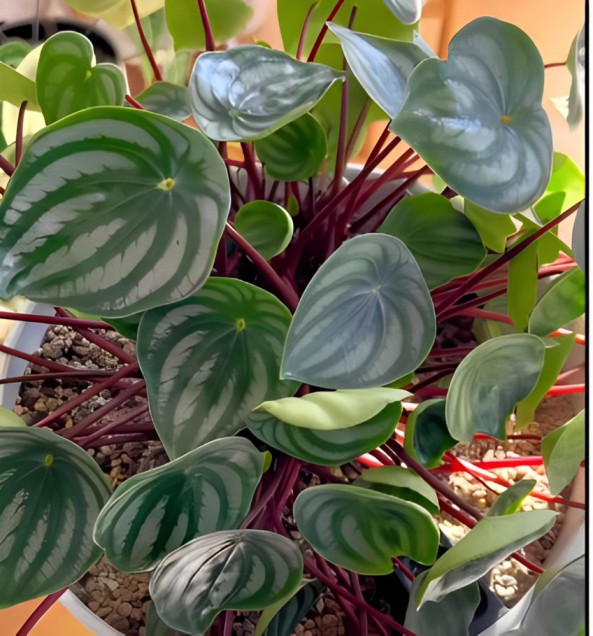
Caring for Your Peperomia Turboensis
To ensure your plant thrives and maintains its vibrant appearance, follow these simple care guidelines:
Light:
Give your Raindrop Radiator Plant plenty of direct, bright light. Although it can withstand certain lower light levels, it will grow most effectively under a lot of filtered sunshine. It should not be placed in direct sunlight as this might burn the delicate foliage.
Watering:
Prior to watering your plant, let the top inch of the soil to get dry. It’s critical to let the soil to gradually dry between waterings since overwatering can cause root rot. To avoid soggy soil, use a well-draining potting mix and a container with drainage holes.
Humidity:
your plant will flourish with a little more moisture, even though it can survive ordinary indoor humidity levels. You may put your plant on a humidity tray or use a room humidifier to boost the humidity surrounding it.
Temperature:
The ideal temperature range for this type of Peperomia is between 65°F and 80°F (18°C and 27°C). Avoid exposing it to temperature changes or draughts.
Fertilization:
During the growth season (spring and summer), feed your plant with a balanced liquid fertiliser diluted to half strength. When the plant’s development slows down in the winter, lessen fertilisation.
Pruning:
You can pinch or cut down lanky stems to promote bushier growth and preserve its structure. This is crucial if your plant starts to grow too tall or sparsely..
There are several varieties are available to collectors and enthusiasts, each with its unique characteristics:
Peperomia-Turboensis ‘Cognito’:
This type is distinguished by its deep green leaves and pronounced silver-white patterns that mimic leaf veins. For those looking for a Peperomia-Turboensis with a little additional flare, it’s an aesthetically attractive alternative.
Peperomia-Turboensis ‘Emerald Ripple’:
This type has textured, undulating leaves that are a deep emerald green, as the name would imply. Its look is given a touch of refinement by the delicate crimson tones around the leaf margins.
Peperomia-Turboensis ‘Raindrop’:
The traditional Raindrop cultivar has glossy, brilliant green foliage. It is a favourite among indoor gardeners because of its straightforward yet alluring look.
How to propagate peperomia from a stem cutting
One of the simplest and most reliable techniques of spreading peperomia is through stem cuttings in water. It’s easy to keep track of the root development of the stem and make sure everything is proceeding well by using translucent containers.
Take Stem Cuttings
Take a stem cutting off your peperomia plant using a pair of clean pruning shears or scissors, making that the stem has leaves on it.
Place Cuttings in Water
Place the cutting in a small vase or jar that has been filled with water. The leaf need to stay on top of the surface. Place the container in a spot with strong, indirect light, and change the water once each week.
Transfer to Soil Once New Leaves Have Sprouted
Roots will begin to grow within the first two weeks, however, it’s best to wait until new leaves have begun to sprout before planting the cutting in soil. Prepare a small container with well-draining potting soil and plant the rooted stem cutting, watering thoroughly after planting. Keep the soil evenly moist for the first week to help the roots acclimate.
The Appeal of Peperomia-Turboensis
Due to its distinctive aesthetic appeal and ease of care, this type of plant has carved out a unique place in the world of indoor plants. It is a flexible option for both novice and expert gardeners due to its small stature and fascinating leaves. This plant is unquestionably a plant worth taking into consideration, whether you’re wanting to add a splash of green to your house or increase your collection of unusual houseplants.
The Turboensis is a living example of how adaptable and beautiful nature is, from its beginnings in lush rainforests to its current status as a cherished houseplant. You’ll have a greater appreciation for the beauties of the natural world that you can bring right into your living area as you take care of and enjoy this magnificent plant.
The Peperomia-Turboensis is a symbol of nature’s flexibility and limitless ingenuity in the world of indoor gardening. For plant aficionados wishing to add to their collection, it is a preferred pick due to its alluring beauty, simplicity of maintenance, and fascinating history. This type of plant is a tiny plant that will bring a touch of elegance and originality to any indoor garden with its glossy, teardrop-shaped leaves. Why not give this extraordinary plant a try and see how it grows and mesmerises in your own home?
FAQs
Peperomia turboensis indoor care?
Bright, indirect light is ideal for Peperomia-turboensis, and it requires dependably wet soil. you preserve its compact, lovely growth inside, be sure you use well-draining pots and periodic trimming.
How to propagate Peperomia turboensis?
It is simple to grow this plant from stem or leaf cuttings. Simply cut off a healthy leaf or stem, let it callus for a day or two, then plant it in a potting mix that allows for good drainage to promote root growth and watch it develop into a new plant.
Peperomia turboensis care?
A charming succulent called Peperomia-turboensis prefers bright, indirect light and needs soil that drains well to avoid overwatering. For optimum growth, keep the soil continuously wet but not saturated.
What are the unique characteristics of this plant that make it a favorite among indoor plant enthusiasts?
For its characteristic round, glossy leaves with pronounced silver stripes, its compact growth habit, and its appropriateness for low to medium interior lighting conditions, Peperomia-Turboensis is prized. Its appeal is partly influenced by how little upkeep it requires.
What are the key care guidelines for maintaining a healthy Peperomia Turboensis plant?
This plant requires bright, indirect light, soil that drains well, and regular watering with an inch of the top soil allowed to dry out in between. During the growth season, fertilization should be used, and pruning may be required to keep the plant’s structure.
How can Peperomia Turboensis be propagated, and what are the recommended methods for successful propagation?
Stem cuttings in soil or water, as well as leaf cuttings, are two ways to multiply. It is crucial to adhere to certain procedures in order to properly propagate, such as making sure stem cuttings have leaves and providing a humid environment for initial development.
Conclusion:
With its distinctive spherical leaves and alluring range of colours, Peperomia Turboensis appears as a charming member of the Peperomia family. Precision in care, a thorough comprehension of each plant’s particular needs, and the provision of a safe environment are essential for successful growing.
Although it is usually believed to be secure for animals, careful ownership is still crucial. In order to ensure you begin on a visually beautiful adventure as a plant parent, whether indoors or outdoors, a treasure wealth of care knowledge is waiting on a variety of web platforms, including YouTube.

